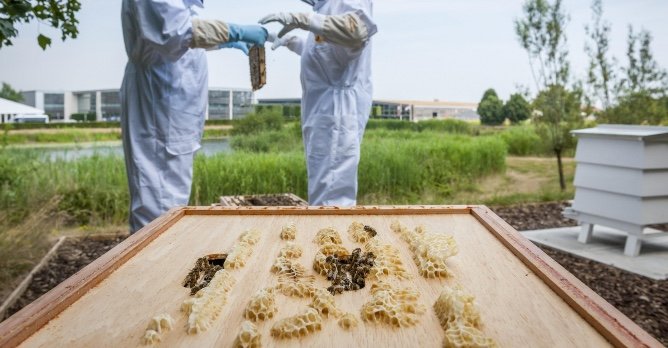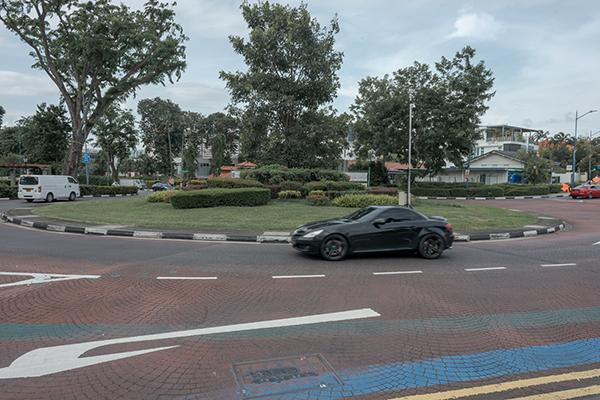Rolls-Royce produces record amount of honey
01 May 2020|411 views
Although car manufacturing has been temporarily suspended, production of another unique, distinctly British treasure is running at record levels at the Home of Rolls-Royce - the world's most exclusive honey.
In their third full season of production, the dedicated 250,000-strong workforce in the company's Apiary are set, once again, to exceed their 2020 volume targets for the 'Rolls-Royce of Honey'.
Having come through the winter in excellent health, Rolls-Royce's English Honey Bees are currently emerging from their hives and foraging on the half-a-million trees, shrubs and wildflowers flourishing across the 42-acre Rolls‑Royce site, plus the eight acres of sedum plants growing on the manufacturing plant’s 'living roof', the largest of its kind in the U.K.
The more adventurous bees make sorties into the surrounding Goodwood Estate, whose 12,000 acres of West Sussex countryside are among the glories of the South Downs National Park.
Established in 2017, the Goodwood Apiary comprises six traditional, English-crafted, wooden beehives, each bearing a polished stainless steel nameplate handcrafted in the company's Bespoke Workshop. Five are named after cars in the Rolls-Royce product family, 'Phantom', 'Wraith', 'Ghost', 'Dawn' and 'Cullinan', while the sixth, the 'Spirit of Ecstasy', celebrates the marque's illustrious mascot. Like the 2,000 employees at the Home of Rolls-Royce, the bees are responsible for producing a rare and desirable product. At the end of each season, 'The Rolls-Royce of Honey' is meticulously hand‑processed by local specialists and served to guests of the marque, including customers commissioning their motor cars in the company's Atelier suite.

However, a shortage of suitable forage, primarily caused by habitat loss, has put their numbers under great and growing pressure in recent years.
The South Downs National Park, on the doorstep of the Home of Rolls-Royce, mirrors this national trend. Chalk downland, which supports pollinators including honey bees, bumblebees and the Adonis blue butterfly, now accounts for just 4% of the National Park's total area, in fragmented pockets that make it harder for pollinators to move through the landscape. Through providential timing, the creation of the Apiary gave an early boost to a new South Downs National Park Trust campaign to address this critical problem. The Bee Lines initiative supports farmers and landowners in creating new flower-rich 'corridors' to link areas of habitat and help bees and other pollinator species to thrive. Residents and businesses within the National Park boundaries are also being encouraged to get involved through initiatives such as planting wildflowers in gardens and grounds.
Although car manufacturing has been temporarily suspended, production of another unique, distinctly British treasure is running at record levels at the Home of Rolls-Royce - the world's most exclusive honey.
In their third full season of production, the dedicated 250,000-strong workforce in the company's Apiary are set, once again, to exceed their 2020 volume targets for the 'Rolls-Royce of Honey'.
Having come through the winter in excellent health, Rolls-Royce's English Honey Bees are currently emerging from their hives and foraging on the half-a-million trees, shrubs and wildflowers flourishing across the 42-acre Rolls‑Royce site, plus the eight acres of sedum plants growing on the manufacturing plant’s 'living roof', the largest of its kind in the U.K.
The more adventurous bees make sorties into the surrounding Goodwood Estate, whose 12,000 acres of West Sussex countryside are among the glories of the South Downs National Park.
Established in 2017, the Goodwood Apiary comprises six traditional, English-crafted, wooden beehives, each bearing a polished stainless steel nameplate handcrafted in the company's Bespoke Workshop. Five are named after cars in the Rolls-Royce product family, 'Phantom', 'Wraith', 'Ghost', 'Dawn' and 'Cullinan', while the sixth, the 'Spirit of Ecstasy', celebrates the marque's illustrious mascot. Like the 2,000 employees at the Home of Rolls-Royce, the bees are responsible for producing a rare and desirable product. At the end of each season, 'The Rolls-Royce of Honey' is meticulously hand‑processed by local specialists and served to guests of the marque, including customers commissioning their motor cars in the company's Atelier suite.

However, a shortage of suitable forage, primarily caused by habitat loss, has put their numbers under great and growing pressure in recent years.
The South Downs National Park, on the doorstep of the Home of Rolls-Royce, mirrors this national trend. Chalk downland, which supports pollinators including honey bees, bumblebees and the Adonis blue butterfly, now accounts for just 4% of the National Park's total area, in fragmented pockets that make it harder for pollinators to move through the landscape. Through providential timing, the creation of the Apiary gave an early boost to a new South Downs National Park Trust campaign to address this critical problem. The Bee Lines initiative supports farmers and landowners in creating new flower-rich 'corridors' to link areas of habitat and help bees and other pollinator species to thrive. Residents and businesses within the National Park boundaries are also being encouraged to get involved through initiatives such as planting wildflowers in gardens and grounds.
Latest COE Prices
June 2025 | 2nd BIDDING
NEXT TENDER: 09 Jul 2025
CAT A$98,124
CAT B$116,670
CAT C$65,000
CAT E$116,889
View Full Results Thank You For Your Subscription.






























